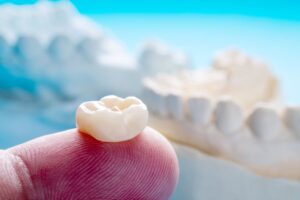
Dental crowns provide many benefits for those with teeth that are cracked or decayed. They can be customized to aesthetically match your natural teeth and restore your smile, for example. They also protect your already damaged tooth from additional harm. One of the greatest advantages, though, is how durable they are. With the right care and maintenance, your crowns can last up to 20 years!
Even with the best of care, though, they are not designed to last forever. Additionally, they’re not infallible! Eventually, your dental crown may need to be examined or replaced. Keep reading to learn four signs that let you know it’s time to consider a new restoration.
Sign 1: It Doesn’t Look Right
If your dental crown is getting old, you might notice visible signs that let you know you need to talk with your dentist. Some dental crowns are attached to an implanted metal rod or consist of porcelain fused to metal. If you notice a dark line along your teeth, you might actually be seeing the metal showing through. If you notice that your dental crown has a dark line around its edge, it’s time to make an appointment.
Sign 2: Gums Are Receding
Your gums may recede from around your crown if the tissue is irritated. This is most often caused by poor oral hygiene, but in rare cases, the edges of a dental crown can trigger gum recession. If you notice that your gums are pulling back away from your dental crown (or natural teeth, for that matter) then it’s important to visit your dentist. They will need to confirm whether it’s placed properly and check for signs of gum disease.
Sign 3: Natural Wear and Tear
Dental crowns are more likely to develop problems once they’ve been in place five years or more. You might find that your dental crown is chipped or cracked, leaving the vulnerable tooth underneath exposed. If you notice any visible damage to your dental crown, make an appointment so your dentist can fit you with a new restoration.
Sign 4: There’s Sensitivity Around The Crowned Tooth
Any sign of swelling, inflammation, or tooth sensitivity around your crowned tooth warrants a call to your dentist. You should not be feeling pain, so if you are, it’s a clear indicator that your dental crown is not protecting the sensitive underlying tooth as it should be. To avoid potential additional damage to the crowned tooth, it’s important to address it as soon as you’re able.
These benchmarks let you know that it’s time to talk with your dentist about a new dental crown. Once it’s in place, you can get back to enjoying the many benefits of a properly restored tooth for years to come!
About the Author
Dr. Robert Mitchell received his bachelor of science degree from the University of Texas at Austin, and then his DDS from Baylor College of Dentistry in Dallas. He has been helping patients achieve beautiful smiles in North Dallas and the surrounding areas since then. He has received multiple awards and has been featured in D Magazine as one of the best dentists in Dallas. If you need to have your dental crown checked, he is more than qualified to help! Feel free to request an appointment on the website or call (972) 233-1311.





